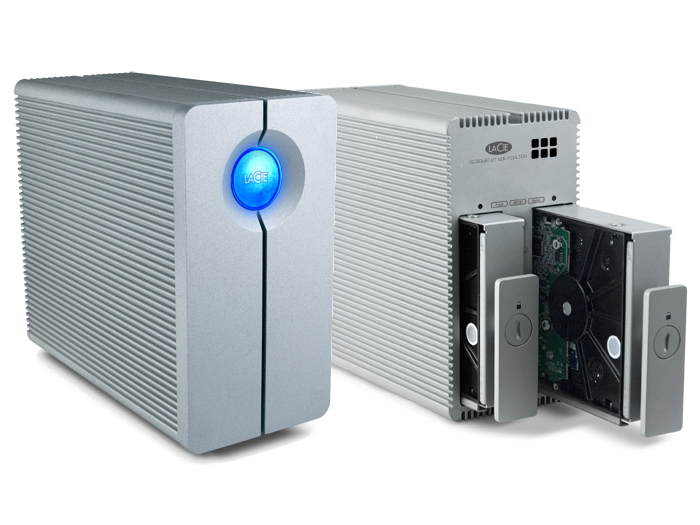LaCie Intros USB 3.0 RAID Storage Solution
LaCie's new external solution provides three RAID modes.
Monday LaCie introduced the world's first USB 3.0-based, external RAID storage solution, the LaCie 2big USB 3.0. The device was developed with professionals in mind who need high reliability and fast transfer speeds of up to 205 MB/s. LaCie also boasts that users can even transfer a 50 GB Blu-ray disc in less than five minutes.
Offering capacities up to 4 TB, the LaCie 2big USB 3.0 contains two 7200 rpm hot-swappable drives and three RAID modes--"Fast" (RAID 0) for the full speed and capacity, "Safe" (RAID 1) for full data protection against disk failure, and JBOD for those wanting to mount the two disks separately for scheduled backups.
"We are proud to announce the first RAID storage solution to fully leverage the performance of the USB 3.0 interface," said Clement Barberis, Product Manager for LaCie’s Professional Desktop Solutions department. "Developed for users that require sizeable data flow, such as print professionals, recording engineers, and video producers, the 2big USB 3.0 allows them to take advantage of high capacities while delivering industry-leading transfer speeds."
The LaCie 2big USB 3.0 can be purchased at the LaCie Online Store, LaCie resellers, and LaCie storage partmers starting at $349.99. A single disk version called the LaCie d2 USB 3.0 version is also available.
Get Tom's Hardware's best news and in-depth reviews, straight to your inbox.

Kevin Parrish has over a decade of experience as a writer, editor, and product tester. His work focused on computer hardware, networking equipment, smartphones, tablets, gaming consoles, and other internet-connected devices. His work has appeared in Tom's Hardware, Tom's Guide, Maximum PC, Digital Trends, Android Authority, How-To Geek, Lifewire, and others.
-
nforce4max Gin FushichoSounds nice, 4 TB's is quite a bit of space.Reply
Till I do my backups and it is already more than half way full :s -
chickenhoagie Correct me if im wrong, because i'm still trying to understand the whole idea of the concept behind speeds of Hard drives..but if these harddrives have write speeds way less than that of the usb 3.0 controller, then isn't there a bottleneck somewhere in here, meaning that the USB controller isn't even using all of its potential? again, please correct me if i'm wrong.Reply -
techseven The more storage space you have, the more crap you are going to keep - that is a fact...Reply -
The_Prophecy Reply9242100 said:Correct me if im wrong, because i'm still trying to understand the whole idea of the concept behind speeds of Hard drives..but if these harddrives have write speeds way less than that of the usb 3.0 controller, then isn't there a bottleneck somewhere in here, meaning that the USB controller isn't even using all of its potential? again, please correct me if i'm wrong.
The bottleneck is the hard drives, but you always want the controller to be faster than the hard drives, as hard drives are one of the slowest components in a PC. USB 3.0 gives us a lot of headroom when referring to a single drive. However, when you start putting drives in RAID 0, USB 3.0 only helps so much. Hopefully Intel's Light Peak technology becomes mainstream, and hopefully it scales up quickly. -
chickenhoagie The_ProphecyThe bottleneck is the hard drives, but you always want the controller to be faster than the hard drives, as hard drives are one of the slowest components in a PC. USB 3.0 gives us a lot of headroom when referring to a single drive. However, when you start putting drives in RAID 0, USB 3.0 only helps so much. Hopefully Intel's Light Peak technology becomes mainstream, and hopefully it scales up quickly.thanks for that reply. just wanted to know if I was right on this or not, because im all too often thumbed down for stating facts like that lol. but what you say does make sense. I guess I was just figuring why have external when internal is just as fast, but I wasn't thinking of the fact of what an external harddrive is for. So I suppose this means that the external basically does become internal, but with external benefits, which I now see as a great product :D. Oh i catch on so quickly don't I? Sorry, 17 and learning.Reply -
crus_russ chickenhoagiethanks for that reply. just wanted to know if I was right on this or not, because im all too often thumbed down for stating facts like that lol. but what you say does make sense. I guess I was just figuring why have external when internal is just as fast, but I wasn't thinking of the fact of what an external harddrive is for. So I suppose this means that the external basically does become internal, but with external benefits, which I now see as a great product . Oh i catch on so quickly don't I? Sorry, 17 and learning.Reply
It is not so much that you would use this to replace an internal drive (external becomes internal), you would use this as you do for backup of large amounts of data. The problem with backing up data over USB 2 (which is convenient) is that it is SLOW. It maxes out at ~30 megs a second when hard drives can write at anywhere from 60-250megs a second (depending on your drive).
This device now lets you backup without the limitation of USB 2.0's slow speeds. With USB 2.0 it would take you all day and night to copy over 2-4TB.
